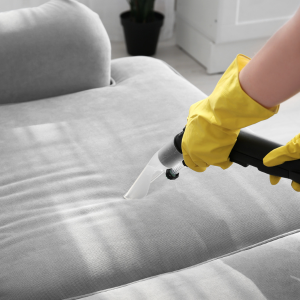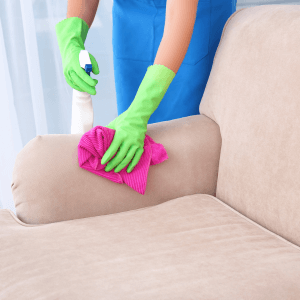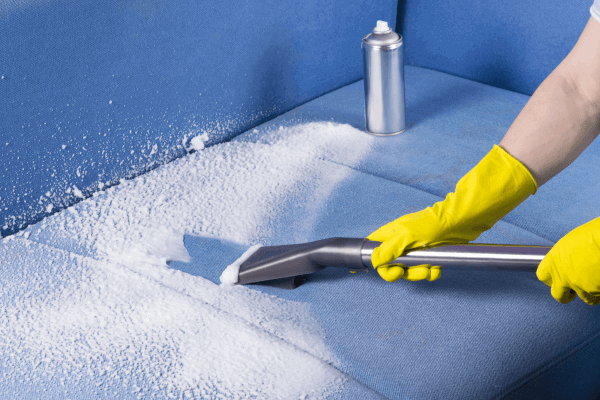Keeping your upholstered furniture clean goes beyond just appearances—it’s about maintaining a healthy and inviting home. Whether you’re battling pet hair, spills, or just everyday wear and tear, knowing how to clean upholstery effectively can save you time and money. This guide from Yesss He Will Carpet Cleaning in Austin, Texas, will walk you through everything you need to know about cleaning upholstery, from understanding fabric codes to mastering deep cleaning techniques. Let’s dive in and help you refresh your furniture like a pro.
Decoding Upholstery Cleaning Codes
Wait! Don’t grab that bottle of cleaner just yet. Take a look at the upholstery cleaning codes on your furniture. These codes aren’t just there for show—they guide you on the best methods and products to use without causing damage.
- W: Safe to clean with a water-based cleaner.
- S: Stick to solvent-based cleaners only.
- W-S: You can use either water-based or solvent-based cleaners.
- X: No liquids allowed—vacuum only.
Can’t find a code? No worries! Test your cleaner on a small, hidden section of the fabric first. This simple step can prevent a cleaning disaster and keep your upholstery looking its best.
Upholstery Cleaning Prep like a Pro
Preparation is half the battle when it comes to cleaning upholstery. Start by gathering all the essentials: a vacuum with attachments, a soft-bristled brush, your chosen cleaning solutions, and microfiber cloths.
Create a designated cleaning area to avoid spreading dirt or stains. Cover nearby furniture and floors with drop cloths or old towels. This not only keeps your home tidy but also makes the cleaning process more efficient
Vacuuming the Upholstery

Vacuuming is the foundation of any successful upholstery cleaning. It removes loose dirt, dust, and debris, making the subsequent steps more effective.
- Use the Right Attachments: A soft-bristled brush attachment is perfect for delicate fabrics, while a crevice tool helps you reach those tight spots.
- Don’t Skip the Nooks: Be thorough—vacuum the entire piece, including the back, sides, and under the cushions.
This step alone can make a noticeable difference in the freshness of your furniture and set the stage for deeper upholstery cleaning.
Spot Cleaning Stains
Spills happen, but stains don’t have to be permanent. The key is quick and appropriate action.
- Identify the Stain: Whether it’s from food, drinks, ink, or pets, knowing the type of stain will guide your upholstery cleaning approach.
- Act Fast for Fresh Stains: Blot (don’t rub!) the area with a clean cloth to absorb as much liquid as possible.
- Handle Dried Stains with Care: Gently scrape off any residue before applying a cleaner. Use water-based cleaners for most stains and solvent-based for oily ones.
Remember to rinse and dry the area thoroughly to avoid any residue buildup that can attract more dirt.
For expert tips on treating various stains, check out the Carpet and Rug Institute’s Stain Removal Guide.
Mastering Steam and Dry Cleaning Techniques
Sometimes, vacuuming and spot cleaning aren’t enough—your upholstery needs a deeper clean. There are two main methods to consider: steam cleaning and dry cleaning.
Steam Cleaning
- Prepare Your Steam Cleaner: Fill the machine with water and the recommended cleaning solution.
- Even Application is Key: Slowly move the cleaner over the fabric to allow the steam to penetrate and lift dirt.
- Drying Matters: Let the furniture dry completely before using it again. Speed up the process with fans or by opening windows.
Dry Cleaning
- Choose the Right Solvent: Not all fabrics are steam-friendly. For these, select a solvent suitable for your fabric type.
- Blot, Don’t Soak: Apply the solvent to a cloth and gently blot the stained area. Over-saturating can damage the fabric.
- Rinse Residue: Use a damp cloth to remove any remaining solvent and let the area dry thoroughly.
Deep cleaning not only refreshes the look of your upholstery but also extends its lifespan by removing deeply embedded dirt and grime.
Tailoring Your Upholstery Cleaning to Different Fabric Types

Not all upholstery is created equal, and different fabrics require different cleaning approaches.
- Cotton and Linen: These natural fibers are prone to shrinking, so stick to water-based cleaners and avoid over-wetting.
- Synthetic Fabrics: Generally durable and easier to clean, synthetics can usually handle water-based cleaners with no issues.
- Leather: Leather needs special care—use a leather cleaner and conditioner to keep it supple and prevent cracks.
- Microfiber: This popular fabric is easy to maintain. Spot clean with a water-based solution and vacuum regularly.
When in doubt, test a small area first or consider hiring a professional for particularly delicate or valuable pieces.
Banish Odors in Your Upholstery
No one wants to sit on a couch that smells less than fresh. Odors in upholstery can come from various sources, but there are effective ways to neutralize them.
- Natural Solutions: Use household items like vinegar and baking soda. Sprinkle baking soda on the fabric, let it sit for a few hours, then vacuum it up. For tougher odors, spray a vinegar solution (equal parts vinegar and water) and let it air dry.
- Commercial Odor Removers: Sometimes, a store-bought solution is the best bet, especially for strong odors like pet accidents.
- Ongoing Freshness: Regularly vacuum your upholstery and consider using fabric fresheners to keep things smelling pleasant.
Read more here about how to remove pet orders easily.
Maintenance Tips to Keep Your Couch Looking New
Consistency is key when it comes to upholstery maintenance. Here’s how to keep your furniture in top shape:
- Weekly Vacuuming: Make it a habit to vacuum your upholstery at least once a week. This removes surface dirt and prevents it from settling into the fabric.
- Quarterly Deep Cleaning: Depending on usage, aim for a deep clean every three to six months.
- Protective Covers: Invest in washable covers to protect your furniture from spills and wear.
- Mind the Rules: Discourage eating and drinking on the furniture to reduce the risk of stains.
DIY vs. Professional Cleaning
While DIY cleaning is great for regular maintenance, some situations call for professional help.
- Tough Stains: If you’ve tried everything and that stain still won’t budge, it’s time to bring in the pros.
- Delicate Fabrics: Certain fabrics, especially antique or luxury materials, are best left to professionals who know how to handle them.
- Time for a Deep Clean: If it’s been a while since your last professional cleaning, consider scheduling one. Professional services like Yesss He Will Carpet Cleaning have the tools and expertise to deep clean your upholstery safely and effectively.
Though professional cleaning may cost more upfront, it can save you money in the long run by extending the life of your furniture.
FAQ About Cleaning Upholstery
How often should I clean my upholstery?
Aim to vacuum your upholstery weekly and deep clean it every 6-12 months, depending on use.
Can I use homemade cleaners on my upholstery?
Yes, but always test a small, hidden area first. Vinegar and baking soda are common, effective options.
What should I do if my upholstery gets stained?
Blot the stain immediately, then apply the appropriate cleaner based on the stain type and fabric.
Know How to Clean Upholstery for Fresh Furniture
Clean upholstery contributes to a beautiful and healthy home. By following the tips in this guide, you’ll keep your furniture looking and smelling fresh for years to come. If you need professional assistance, Yesss He Will Carpet Cleaning is here to help. Call us at (512) 638- 8663 or book online to schedule your appointment today. Let’s keep your furniture in top condition!

